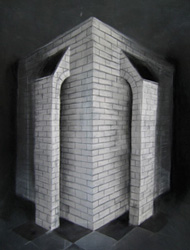Adam Putnam, Untitled (Flying Buttress), 2007.
Born 1973 in New York, New York; lives in New York, New York
Adam Putnam’s recent light installations explore the psychoperceptual dimensions of space with ingenuity and humor. “Sundial” (Eclipse) (2007) is a case in point. The sculpture consists of two obeliskshaped forms, one of wood and the other a mirror, placed upright on the floor. Light from a hooded lamp placed a few feet away bounces off the mirror onto a wall, where its obelisk-shaped reflection falls directly on the shadow cast by the wooden figure. In this dramatic duel between light and dark neither side wins. “Shadow and light cancel each other out,” observes the artist, who says he was “trying to make a shape completely disappear, an eclipsed image.”
Putnam acknowledges that the obelisk may remind viewers of the Washington Monument in DC, but he is less concerned with politics than with the ineffable quality of space. This is evident in the Magic Lantern installations he has been producing since 2004, named after the protocinematic theatrical device that uses an oil lamp and painted slides to project images. In Putnam’s versions, a low-wattage bulb is suspended inside a transparent boxlike container resting on a pedestal. The light passing through the structure’s internal supports and sides limns a ghostly illusionistic architectural image on the walls. Pieces of opaque tape a≈xed to the container’s surface cast shadows that appear as phantom doors and other architectural details. By installing mirrors inside, as he does for his Biennial piece, Green Hallway (Magic Lantern) (2007), Putnam is able to multiply the illuminations, creating illusionistic architectural spaces on the surrounding walls. “These are small, virtual rooms, and you project yourself into them imagining yourself into the space,” he says.
Earlier in his career, Putnam enacted Bruce Naumanesque performances in which he strapped himself into a corner or contorted his large frame into a bookcase. “There’s always been a weird, flat-footed play with the body becoming architecture and following that to its logical—either funny or perverse—conclusion,” he says. He has made black-and-white self-portrait photographs in which he appears shirtless with a sneaker taped to his cheek, or on all fours wearing his pants on his head and arms. According to the artist, these grainy, amateurish pictures of absurd acts pay homage to the Conceptual art of the 1970s.
Increasingly, Putnam is allowing space itself to be the protagonist. For the video projection The Way Out (2005), he shot a model of a three-walled room, then removed the back wall and fit the diorama snugly around a computer screen on which he displayed the original video and reshot the setup, repeating the process to create an endless recession of rooms. With captivating artifice, Putnam’s multidisciplinary inquiry into the imaging of space challenges the eye and teases the mind. JASON EDWARD KAUFMAN
Adam Putnam, Untitled (Flying Buttress), 2007. Mixed media on paper, 28 x 22 in. (71.1 x 55.9 cm). Private collection.

























